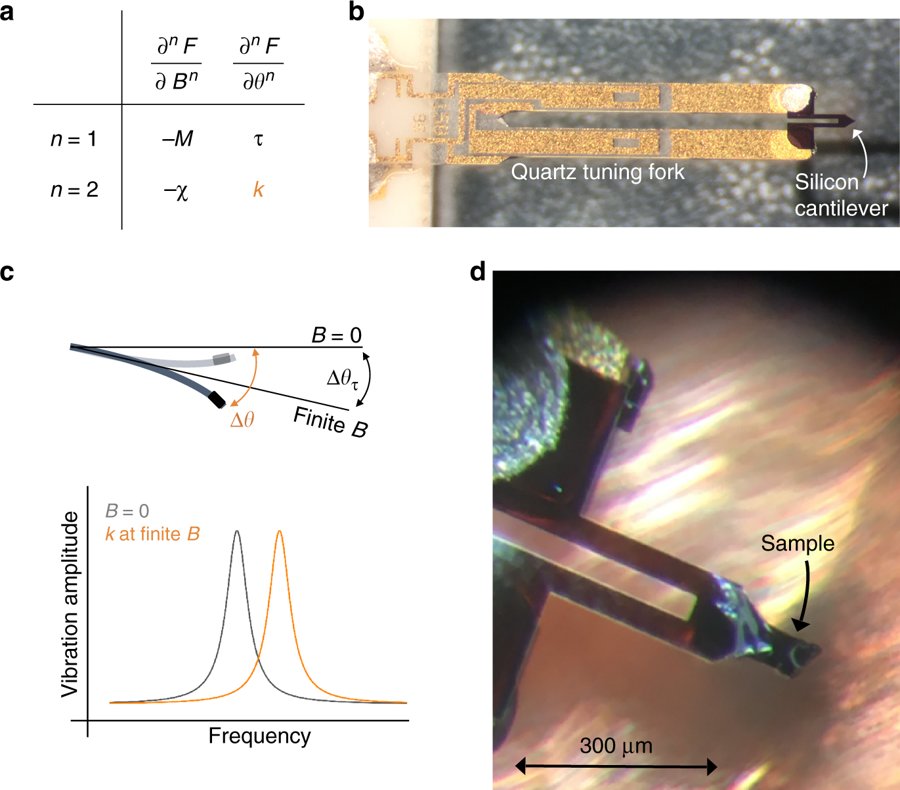Who said that AFM probes can only be used for Atomic Force Microscopy?
In the article “Resonant torsion magnetometry in anisotropic quantum materials” which just appeared in Nature Communications, K. A. Modic, Maja D. Bachmann, B. J. Ramshaw, F. Arnold, K. R. Shirer, Amelia Estry, J. B. Betts, Nirmal J. Ghimire, E. D. Bauer, Marcus Schmidt, Michael Baenitz, E. Svanidze, Ross D. McDonald, Arkady Shekhter and Philip J. W. Moll use the NANOSENSORS™ Akiyama-probe for resonant torsion magnetometry.

Figure 1 from “Resonant torsion magnetometry in anisotropic quantum materials”: Schematic overview of resonant torsion magnetometry a First and second derivatives of the free energy with respect to the magnetic field B and the field orientation θ. b The quartz tuning fork of the Akiyama A-probe (http://www.akiyamaprobe.com) is electrically excited at the lowest-resonance mode of the silicon cantilever, producing a large out-of-plane motion at the tip of the cantilever. c Schematic representing the principle of measuring the magnetotropic coefficient k. In a magnetic field, the magnetic torque brings the lever to a new equilibrium position. The magnetic energy of the samples changes the effective stiffness of the lever, leading to a shift in the resonant frequency. d The silicon cantilever glued to each leg of the quartz tuning fork with a single crystal of RuCl3 mounted at the tip with Bayer silicone grease
There are three advantages why it makes sense to divert the NANOSENSORS™ Akiyama-probe from it’s orginal intended use and use it for resonant torque magnetometry instead:
1. the relatively large spring constant of the silicon cantilever allows the authors to extend ultrasensitive and dynamic cantilever magnetometry to macroscopic sample sizes
- “the placement of the sample on the silicon cantilever (rather than one leg of a quartz tuning fork) eliminates complications that arise from the center of mass motion of the tuning fork coupling to the resonance mode
3. the electrical read-out of the A-probe eliminates the need for optical detection of the resonant frequency, thus making setup relatively straightforward and more robust compared to previous approaches.”*
*K. A. Modic, Maja D. Bachmann, B. J. Ramshaw, F. Arnold, K. R. Shirer, Amelia Estry, J. B. Betts, Nirmal J. Ghimire, E. D. Bauer, Marcus Schmidt, Michael Baenitz, E. Svanidze, Ross D. McDonald, Arkady Shekhter; Philip J. W. Moll
Resonant torsion magnetometry in anisotropic quantum materials
Nature Communications, volume 9, Article number: 3975 (2018)
DOI: https://doi.org/10.1038/s41467-018-06412-w
For the full article please follow this external link: https://rdcu.be/7Z0A
Open Access The article “Resonant torsion magnetometry in anisotropic quantum materials” by K.A. Modic et. al is licensed under a Creative Commons Attribution 4.0 International License, which permits use, sharing, adaptation, distribution and reproduction in any medium or format, as long as you give appropriate credit to the original author(s) and the source, provide a link to the Creative Commons license, and indicate if changes were made. The images or other third party material in this article are included in the article’s Creative Commons license, unless indicated otherwise in a credit line to the material. If material is not included in the article’s Creative Commons license and your intended use is not permitted by statutory regulation or exceeds the permitted use, you will need to obtain permission directly from the copyright holder. To view a copy of this license, visit http://creativecommons.org/licenses/by/4.0/.